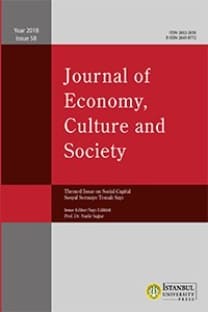On Determinants of Exchange Market Pressure in Turkey: The Role of Model Uncertainty
Macroeconomic and financial indicators have a significant impact on the exchange market pressure (EMP) in Turkey. Despite the huge amount of literature on the subject, there is no study focusing on Turkey that takes into account the role of model uncertainty on exchange market pressure. The role of model uncertainty should be taken into consideration, given the lack of a unique theoretical framework on the exchange markets pressure and a set of numerous explanatory variables. The Bayesian model averaging (BMA) technique is capable of determining as to whether any explanatory variable should be included in the analysis, i.e. the models with high posterior probability. To this end, the determinants of the exchange market pressure index (EMPI) in Turkey for the period of 2010M1-2020M3 are identified using the Bayesian model averaging which takes into account the role of model uncertainty. Model results indicate that the slope of the yield curve, domestic credit growth, the long term yield differentials, and short-term portfolio flows play a significant role as determinants of the exchange rate pressures of Turkey.
___
- Aizenman, J. and Binici, M. (2015). Exchange market pressure in OECD and Emerging economies: Domestic vs. external factors and capital flows in the old and new normal. NBER Working Paper, 2-34. google scholar
- Aktaş, Z. and Kaya Ekşi, N. (2020). What drives portfolio flows to Turkey? The dynamics and a historical accounting of the flows. CBRT Research Notes in Economics, 2-14. google scholar
- Babecky, J., Havrânek T., Mateju J., Rusnâk, M., Smidkovâ, K. and Vasicek, B. (2012). Leading indicators of crisis incidence: Evidence from developed countries. ECB Working Paper Series, No:1486, 1-28. google scholar
- Balakrishnan, R., Danninger, S., Elekdag, S. and Tytell, I. (2009). The transmission of financial stress from advanced to emerging economies. IMF Working Paper, 3-52. google scholar
- CBRT. (2019). Inflation Report 2019-II. google scholar
- Chen, Y. and Tsang, K. (2013). What does the yield curve tell us about exchange rate predictability? Review of Economics and Statistics, 95(1), 185-205. google scholar
- Claessens, S. and Kose, M. A. (2017). Asset prices and macroeconomic outcomes: A survey. Policy Research Working Paper 8259, World Bank Group, 1-92. google scholar
- Crespo Cuaresma, J. and Slacik, T. (2009). On the determinants of currency crises: the role of model uncertainty”, Journal of macroeconomics, 31(4), 621-632. google scholar
- Eicher, T.S., Papageorgiou, C. and Raftery, A. E. (2011). Default priors and predictive performance in Bayesian model averaging, with application to growth determinants. Journal of Applied Econometrics, 26, 30-55. google scholar
- Estrella, A. and Trubin, M. R. (2006). The yield curve as a leading ındicator: Some practical issues. Current Issues in Economics and Finance, 12(5), 1-7. google scholar
- Feldkircher, M. and Zeugner, S. (2009). Benchmark priors revisited: On adaptive shrinkage and the supermodel effect in Bayesian model averaging. IMF Working Papers 09/202, 3-39. google scholar
- Feldkircher, M., Horvath, R. and Rusnak, M. (2014). Exchange market pressures during the financial crisis: A Bayesian model averaging evidence. Journal of International Money and Finance, 40, 21-41. google scholar
- Girton, L. and Roper, D. (1977). A monetary model of exchange market pressure applied to the Postwar Canadian experience. American Econonic Review, 67(4), 537-548. google scholar
- Gourinchas, P.O. and Rey, H. (2016). Real interest rates, imbalances and the curse of regional safe asset providers at the zero lower bound. NBER Working Paper, No.22618. google scholar
- Kara, H., Özlü, P. and Ünalmış, D. (2015). Türkiye için finansal koşullar endeksi. Central Bank Review, 15, 41-73. google scholar
- Koop, G. (2003). Bayesian Econometrics. John Wiley and Sons. google scholar
- Ley, E. and Steel, M.F.J. (2009). On the effect of prior assumptions in Bayesian model averaging with applications to growth regression. Journal of Applied Econometrics, 24, 651-674. google scholar
- Ley, E. and Steel, M.F.J. (2012). Mixtures of g-priors for Bayesian model averaging with economic applications. Journal of Econometrics, 171(2), 251-266. google scholar
- Liang, F., Paulo, R., Molina, G., Clyde, M. A. and Berger, J.O. (2008). Mixtures of g-priors for Bayesian variable selection. Journal of the American Statistical Association, 103, 410-423. google scholar
- Öğünç, F., Özmen, M. U. and Sarıkaya, Ç. (2018). Inflation dynamics in Turkey from a Bayesian perspective. CBRT Working Paper, No: 18/10, 1-25. google scholar
- Patnaik, I. and Pundit, M. (2019). Financial shocks and exchange market pressure. Asian Development Bank Economics Working Paper Series, No: 581, 1-28. google scholar
- Takats, E. and Vela, A. (2014). International monetary policy transmission. BIS Papers, No:78, 25-44. google scholar
- Van Poeck, A., Vanneste, J. and Veiner, M. (2007). Exchange rate regimes and exchange market pressure in the new EU member states. Journal of Common Market Studies, 45(2), 459-485. google scholar
- Vlaar, P. J. G. (1999). Currency crises models for emerging markets. Netherlends Central Bank, Retrieved from https://ideas.repec.org/p/dnb/wormem/595.html. google scholar
- Zeugner, S. (2011). Bayesian model averaging with BMS. Retrieved from https://cran.r-project.org/web/packages/ BMS/vignettes/bms.pdf. google scholar
- ISSN: 2602-2656
- Yayın Aralığı: Yılda 2 Sayı
- Başlangıç: 1960
- Yayıncı: İstanbul Üniversitesi Yayınevi
Sayıdaki Diğer Makaleler
Yönetsellik İdeolojisinin Kadına Yönelik Hizmet Sunan Kamu Kurumlarına Yansıyan Etkileri
Tuğçe Uğur GÜLER, Derya ŞAŞMAN KAYLI
Bir Politik “Anamnenis” Örneği Olarak Ayasofya’nin İbadete Açılması Meselesi
Özlem GÜZEL, Eren NACAK, Evrim BİLGİ, Volkan KALIN
Rumyana STOYANOVA, Slaveyah GORANOVA
Sun FEİHAN, Dai HAIDONG, Ye CHONGLIANG, Miao XUMEI
Olya ILYASH, Ruslan LUPAK, Iryna DZHADAN, Ruslan KOLİSHENKO
Aile-İş Kolaylaştırması, Cinsiyet ve Toplumsal Cinsiyet: Üniversite Çalışanları Örneği
